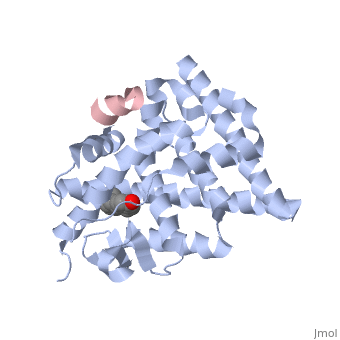Estrogen receptor: Difference between revisions
Michal Harel (talk | contribs) No edit summary |
Michal Harel (talk | contribs) No edit summary |
||
| Line 6: | Line 6: | ||
[[Ivan Koutsopatriy estrogen receptor]]<br /> | [[Ivan Koutsopatriy estrogen receptor]]<br /> | ||
[[C-di-GMP receptors with PilZ domain]]<br /> | [[C-di-GMP receptors with PilZ domain]]<br /> | ||
For more details on ERβ see [[Student Project | For more details on ERβ see [[Student Project 10 for UMass Chemistry 423 Spring 2015]]. | ||
Revision as of 13:00, 22 February 2016
 Estrogen receptors (ER) are activated by the hormone estrogen (EST). The activated ER binds DNA and regulates the activity of many genes. There are 2 forms of ER: α and β and ER dimers can be of αα, ββ and αβ. ER is composed of 5 domains: N terminal A/B domain can transactivate transcription without binding estrogen; C domain (DBD) binds to Estrogen response elements of DNA; D domain is a hinge region; E domain is ligand binding (LBD) as well as binding the coactivator and corepressor proteins and transactivates gene transcription. For more details see
Structure of estradiol metal chelate and estrogen receptor complex: The basis for designing a new class of SERMs [1] Selective estrogen receptor modulators, such as estradiol 17-derived metal complexes, have been synthesized as targeted probes for the diagnosis and treatment of breast cancer. Here, we report the detailed 3D structure of bound with a novel at 2.6 resolution. The residues with EPTA-Eu. The hydrogen bonds are shown as white dashed lines. of this structure with the structure of native ligand 17β-estradiol (E2) in the complex of E2/ERα-LBD complex (1ere) reveals that the . The made by additional estrogen receptor residues (e.g. Glu419 of H7 and Glu339 of H3, this depends on subunit), may work together with the E2 17β hydroxyl-His524 hydrogen bond and tighten the neck of the LBP upon binding of the endogenous ligand E2. 4-Hydroxytamoxifen (OHT) is an other selective estrogen receptor modulator. of EPTA-Eu/ERα-LBD complex on OHT/ERα-LBD complex (3ert) shows that there is similar network of hydrogen bonds in both complexes, except for His524 which does not form hydrogen bond with OHT in the OHT/ERα-LBD complex. E2/ERα-LBD (1ere), OHT/ERα-LBD (3ert) and EPTA-Eu/ERα-LBD shows that they overlap well in the majority portions of the domain, but differ significantly in the region of the 'omega loop'. They display different synergistic reciprocating movements, depending on the specific nature of the ligand bound. The structure of estrogen receptor complexed with EPTA-Eu provides important information pertinent to the design of novel functional ER targeted probes for clinical applications.
|
| ||||||||||
3D structures of estrogen receptor3D structures of estrogen receptor
Updated on 22-February-2016
Reference
- ↑ Li MJ, Greenblatt HM, Dym O, Albeck S, Pais A, Gunanathan C, Milstein D, Degani H, Sussman JL. Structure of estradiol metal chelate and estrogen receptor complex: The basis for designing a new class of selective estrogen receptor modulators. J Med Chem. 2011 Apr 7. PMID:21473635 doi:10.1021/jm200192y
